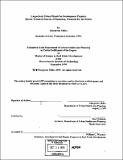| dc.contributor.advisor | Karl Seidman. | en_US |
| dc.contributor.author | Milles, Margretta, 1969- | en_US |
| dc.contributor.other | Massachusetts Institute of Technology. Dept. of Urban Studies and Planning. | en_US |
| dc.date.accessioned | 2007-03-12T17:43:17Z | |
| dc.date.available | 2007-03-12T17:43:17Z | |
| dc.date.copyright | 1999 | en_US |
| dc.date.issued | 1999 | en_US |
| dc.identifier.uri | http://hdl.handle.net/1721.1/36675 | |
| dc.description | Thesis (S.M.)--Massachusetts Institute of Technology, Dept. of Urban Studies and Planning, 1999. | en_US |
| dc.description | Includes bibliographical references (leaves 49-51). | en_US |
| dc.description.abstract | Large-scale urban mixed-use projects continue to be among the most interesting and complicated forms of real estate development. Understanding the barriers in obtaining financing to them, as well as how trends and changes in the real estate capital markets over the past decade have affected their financing is the main purpose of this thesis. Major barriers to obtaining financing in the 1990s included substantially larger equity requirements than in the 1980s, entity design and single property type focus of REITs, and diversification, loan size, and standardization of process of CMBS. Consolidation and segmentation trends in commercial banking were evident, however their effects on financing opportunities were unclear at the time of this study. Trends and changes in the capital markets during the 1990s have created a context for financing real estate projects that is quite different than that of the 1980s. Overall, lenders are much less aggressive than in the 1980s and volatility and a focus on liquidity and standardization are now important. The real estate capital markets of the 1990s offer many more options, contain many more players, and have become much more sophisticated and complex. The approaches to financing large-scale urban mixed-use development projects being taken by the three companies considered illustrate how financing in the 1990s seems to be less project specific and involve a longer-term strategy because capital sources often are financing organizations more than projects. They have adapted to, and leveraged, the changes in the real estate capital markets of the 1990s by employing strategies that include the greater use of equity, sharing of ownership, and use of securitized equity and debt. Public sector involvement in large-scale urban mixed-use projects is still an important component and likely will continue to be, as well as the participation of large private institutional investors such as life insurance companies and pension funds. | en_US |
| dc.description.statementofresponsibility | by Margretta Milles. | en_US |
| dc.format.extent | 52 leaves | en_US |
| dc.language.iso | eng | en_US |
| dc.publisher | Massachusetts Institute of Technology | en_US |
| dc.rights | M.I.T. theses are protected by copyright. They may be viewed from this source for any purpose, but reproduction or distribution in any format is prohibited without written permission. See provided URL for inquiries about permission. | en_US |
| dc.rights.uri | http://dspace.mit.edu/handle/1721.1/7582 | |
| dc.subject | Urban Studies and Planning. | en_US |
| dc.title | Large-scale urban mixed-use development projects : recent trends in sources of financing, prospects for the future | en_US |
| dc.type | Thesis | en_US |
| dc.description.degree | S.M. | en_US |
| dc.contributor.department | Massachusetts Institute of Technology. Department of Urban Studies and Planning | |
| dc.identifier.oclc | 45039695 | en_US |
